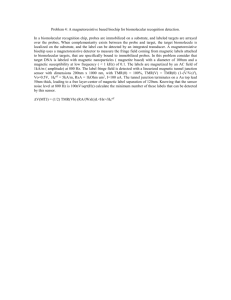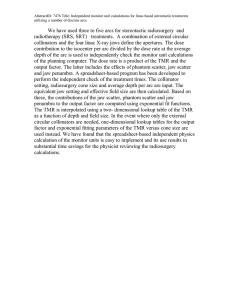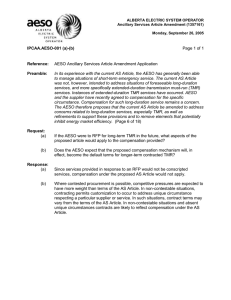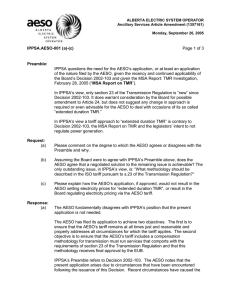ALBERTA ELECTRIC SYSTEM OPERATOR Ancillary Services Article Amendment (1357161)
advertisement
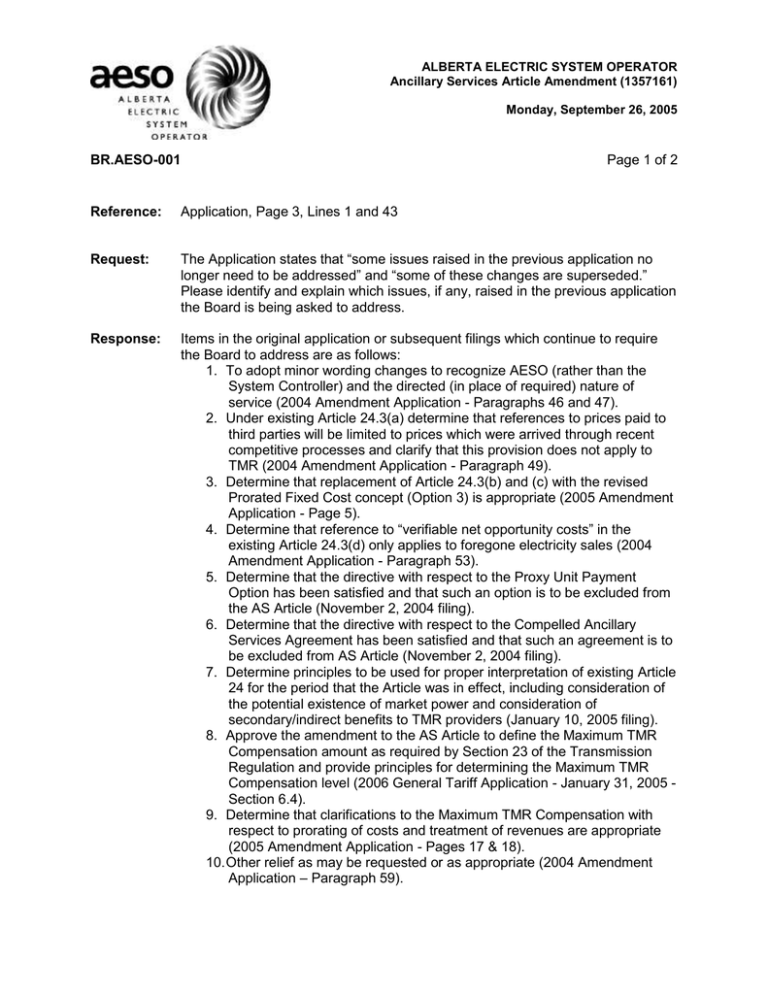
ALBERTA ELECTRIC SYSTEM OPERATOR Ancillary Services Article Amendment (1357161) Monday, September 26, 2005 BR.AESO-001 Page 1 of 2 Reference: Application, Page 3, Lines 1 and 43 Request: The Application states that “some issues raised in the previous application no longer need to be addressed” and “some of these changes are superseded.” Please identify and explain which issues, if any, raised in the previous application the Board is being asked to address. Response: Items in the original application or subsequent filings which continue to require the Board to address are as follows: 1. To adopt minor wording changes to recognize AESO (rather than the System Controller) and the directed (in place of required) nature of service (2004 Amendment Application - Paragraphs 46 and 47). 2. Under existing Article 24.3(a) determine that references to prices paid to third parties will be limited to prices which were arrived through recent competitive processes and clarify that this provision does not apply to TMR (2004 Amendment Application - Paragraph 49). 3. Determine that replacement of Article 24.3(b) and (c) with the revised Prorated Fixed Cost concept (Option 3) is appropriate (2005 Amendment Application - Page 5). 4. Determine that reference to “verifiable net opportunity costs” in the existing Article 24.3(d) only applies to foregone electricity sales (2004 Amendment Application - Paragraph 53). 5. Determine that the directive with respect to the Proxy Unit Payment Option has been satisfied and that such an option is to be excluded from the AS Article (November 2, 2004 filing). 6. Determine that the directive with respect to the Compelled Ancillary Services Agreement has been satisfied and that such an agreement is to be excluded from AS Article (November 2, 2004 filing). 7. Determine principles to be used for proper interpretation of existing Article 24 for the period that the Article was in effect, including consideration of the potential existence of market power and consideration of secondary/indirect benefits to TMR providers (January 10, 2005 filing). 8. Approve the amendment to the AS Article to define the Maximum TMR Compensation amount as required by Section 23 of the Transmission Regulation and provide principles for determining the Maximum TMR Compensation level (2006 General Tariff Application - January 31, 2005 Section 6.4). 9. Determine that clarifications to the Maximum TMR Compensation with respect to prorating of costs and treatment of revenues are appropriate (2005 Amendment Application - Pages 17 & 18). 10. Other relief as may be requested or as appropriate (2004 Amendment Application – Paragraph 59). Page 2 of 2 Items in the original application or subsequent filings which are no longer required to be addressed by the Board are as follows: 1. Replacement of Article 24.3(b) and (c) with the Going Forward Cost Concept (2004 Amendment Application - Paragraphs 50 to 52, and 54). 2. Confirm that any settlements under existing Article 24 are interim and subject to adjustment (Aug 16, 2004 Amendment Application – Paragraph 59). This request has been addressed in the Board’s letter dated December 16, 2004. AESO is not withdrawing any of the evidence or filings made prior to the 2005 Amendment Application. 2 ALBERTA ELECTRIC SYSTEM OPERATOR Ancillary Services Article Amendment (1357161) Monday, September 26, 2005 BR.AESO-002 Reference: Page 1 of 1 Application, Page 7 Request: (a) Please provide a copy of the Department of Energy (DOE) paper referenced in Section 2.1. (b) Please provide a copy of any relevant papers issued by the DOE as a result of its market review process. Response: (a) The ADOE Electricity Policy Framework is attached as Att.BR.AESO-002 A. (b) An ADOE discussion paper titled “Refinement Options for Alberta’s Wholesale and Retail Electric Markets” dated March 10, 2005 is attached as Att.BR.AESO-002 B. ALBERTA ELECTRIC SYSTEM OPERATOR Ancillary Services Article Amendment (1357161) Monday, September 26, 2005 BR.AESO-003 (a)-(b) Page 1 of 2 Reference: Application, Page 8, Lines 10-23 Request: (a) Does the AESO consider that principle 2 of the “remaining principles” described on p. 8 of the consolidated application would generally be dealt with through an application pursuant to section 8(3) of the Transmission Regulation for an exemption from section 8(1)(f) of the Transmission Regulation? If not, please explain why not. (b) Relative to principles 3, 4 and 7 of the “remaining principles” described on p. 8, please explain what role, if any, the Board should have in scrutinizing the procurement of TMR services. Response: Note that the original question referred to 8(1)(g) but the EUB advised that the correct section should be 8(1)(f). The change has been made in the question above. (a) Yes. The AESO would expect principle 2 to be considered in made applications pursuant to Section 8(3) of the Transmission Regulation. As noted in the present application, principles 2, 3, 4, and 7 relate to AS procurement processes. The procurement process principles were mentioned in the 2005 Amendment Application for completeness, even though the present application is to address compensation issues under conscription of services. Regarding the current status of procurement processes, on June 17, 2005 the AESO posted to its web site an Ancillary Services Procurement Process, Version 1 (Please see Att.BR.AESO-003). The AESO continues to work with stakeholders and the Market Surveillance Administrator to further develop processes and business practices around competitive procurement of Ancillary Services, including a process for determining if specific circumstances results in a situation that is either contestable or noncontestable. The objective is to develop a comprehensive transparent process. The MSA is expected to actively monitor such processes. Over the past 18 months, the AESO has taken a number of other actions designed to minimize the use of conscription, facilitate transparency and encourage competition in ancillary services as witnessed by the following: Implementation of Request for Proposals (RFP) for Calgary Area TMR service; Implementation of RFP for Load Shedding Services (LSS); Underfrequency Mitigation Services Procurement Plan; Page 2 of 2 Publication of Operating Reserve Procurement Guidelines; Daily publication of Over-The-Counter and Watt-Ex prices for Operating Reserves; and Notification that Rossdale generating units were to be contracted for TMR service. For near-term congestion issues where transmission enhancements solutions are not possible, AESO is identifying and forecasting TMR needs as early as possible so contestable procurement can occur. The AESO is not requesting inclusion of competitive procurement processes and practices in the tariff, nor requesting Board approval of such processes. (b) It is the AESO’s view that the Board’s role is to determine that the costs of TMR services procured are just and reasonable during General Tariff Applications. 2 ALBERTA ELECTRIC SYSTEM OPERATOR Ancillary Services Article Amendment (1357161) Monday, September 26, 2005 BR.AESO-004 (a)-(c) Reference: Page 1 of 2 Application, Page 14, Fixed Costs Request: (a) Please provide examples illustrating how the AESO would calculate payment for fixed costs in situations where pool price was relatively high (above variable cost) and relatively low (below variable cost). (b) Please explain how items such as major maintenance inspections/repairs (those occurring every few years) would be accounted for. (c) Please complete the examples by illustrating how all variable costs would be accounted for. Response: (a) Attachment BR.AESO-004 contains illustrative examples of TMR costs, including fixed cost compensation, to the AESO for each compensation option under different pool price or out-of-merit scenarios. The maximum TMR compensation level as proposed is also shown. The workbook illustrates the generator’s revenue from the energy market, revenue from TMR compensation and aggregate revenue. The revenues less variable costs provide a contribution to the fixed costs of the generator. The aggregate contribution to fixed costs as a percentage of fixed costs is estimated. Included for reference is a case with no TMR direction where operations would be solely for the energy market. A competitive TMR reference case is shown and is based on prices resulting from competitive processes for TMR services. The worksheet also includes examples assuming a 50% directed level and a 25% directed level. Scenarios A and B are cases where pool price are greater than a unit’s variable costs as would generally be the case for coal units. As such, the unit is in-merit most of the time with few out-of-merit periods. TMR costs are generally lower. Scenarios D and E are cases for units with a higher heat rate or lower efficiency relative to the system. Examples would be gas-fired thermal units or less efficient cogeneration units The unit’s variable costs are generally greater than the pool price and therefore there are more out-of-merit periods. Scenario C is a mid-scenario. Page 2 of 2 The values plotted do not account for any effects of perverse incentives under the existing Article 24 as described in the Amendment Application. Cost increases due to the existence of perverse incentives would be in addition to costs shown. The workbook shows the formulas used for each option and the assumptions. The workbook is intended to show simplified scenarios using assumptions about the variation of pool price over a month and assuming simple directed operation patterns. The workbook is not based on detailed hourly modeling or actual results. (b) Compensation of major maintenance expenses would be calculated in a manner consistent with the accounting treatment reflected in the Customer’s audited financial statements. (c) Under Option 3, variable costs would be compensated for under the formula described in Article 11.3(b)I of the tariff (Appendix B of the 2005 Amendment Application). Compensation for such costs occurs only during out-of-merit periods and would be calculated on an hourly basis, unlike fixed and indirect costs. The out-of-merit payment is equal to the energy generated (MWh) in compliance with the directive multiplied by the (Benchmark price less Pool price) ($/MWh). 2 ALBERTA ELECTRIC SYSTEM OPERATOR Ancillary Services Article Amendment (1357161) Monday, September 26, 2005 BR.AESO-005 (a)-(c) Reference: Request: (a) Page 1 of 1 Appendix A, Page 1, proposed Article 11.3 (b) and 11.3(c) In respect of the proposed Article 11.3(b), please confirm that the compensation formula proposed would apply only in respect of conscripted TMR services and not in respect of other types of Ancillary Services that the AESO may acquire on a conscripted basis. If this cannot be confirmed, please explain. (b) In respect of the proposed Article 11.3(c), please confirm that this Article is intended to apply in respect of Ancillary Services other than conscripted TMR, but not to the conscription of TMR. If this cannot be confirmed, please explain why compensation pursuant to Article 11.3(c) rather than Article 11.3(b) for a TMR unit would be permitted under section 23(1) of the Transmission Regulation. (c) If the AESO considers that Article 11.3(c) could apply to conscripted TMR services, by way of example, please provide an illustration of how “verifiable net opportunity cost” would be defined and determined. Response: (a) Not confirmed. Article 11.3(b) is not limited to TMR services and could be applied to Ancillary Services other than TMR. The main use of 11.3(b) will be for services involving energy production as is the case with TMR. It is noted that Article 11.3(b) i only yields a positive number for ancillary services where energy is generated and thus would have limited application for services such as Operating Reserves, except for any energy actually generated related to the provision of Operating Reserve Service. (b) Not confirmed. Article 11.3(c) is expected to apply to non thermal units such as hydro units. This would occur if a hydro unit was directed to provide TMR service and use limited hydro storage rather than save the stored water for a verifiably better opportunity. AESO does not consider compensation for a verifiable net opportunity cost related to foregone electricity sales to be prohibited by the Transmission Regulation. (c) By way of example, if a hydro unit was directed to provide TMR service when the pool price was $30/MWh and provision of the TMR service caused a verifiable lost opportunity to generate in another period when pool price was $50, the verifiable net opportunity cost would be $50 less $30 or $20/MWh. ALBERTA ELECTRIC SYSTEM OPERATOR Ancillary Services Article Amendment (1357161) Monday, September 26, 2005 BR.AESO-006 Page 1 of 1 Reference: Appendix A, Page 2, Average Monthly Fixed Costs Request: Please elaborate as to how this provision satisfies section 23(3) of the Transmission Regulation. Response: The reference to Average Monthly Fixed Costs on page 2 of Appendix A is for the purpose of determining compensation for conscripted AS services under Article 11. The reference in Appendix A is not for the purposes of determining the TMR Maximum as required by Section 23(3) of the Transmission Regulation. The determination of TMR maximum compensation for purposes of Section 23(3) of the Transmission Regulation is included in Appendix B. ALBERTA ELECTRIC SYSTEM OPERATOR Ancillary Services Article Amendment (1357161) Monday, September 26, 2005 BR.AESO-007 Page 1 of 1 Reference: Appendix E, Line 14 Request: Please explain how the credit for common costs is arrived at. Response: The intent of the credit is to recognize that some generation facilities, in addition to generating electricity, provide services to industrial and other processes and determine a TMR cost of service which reflects the TMR use of such shared or common facilities. Please refer to Amendment Application Appendix B, page 7 for a further description of common costs. The steps are shown in Appendix E of the Amendment Application at lines 14, and 49 to 53. The customer provides the amount of the credit for common costs (line 14). The credit amount would include revenue and other benefits received from the provision of other services. In steps 50 to 53 the amount to prorated to TMR is calculated.


